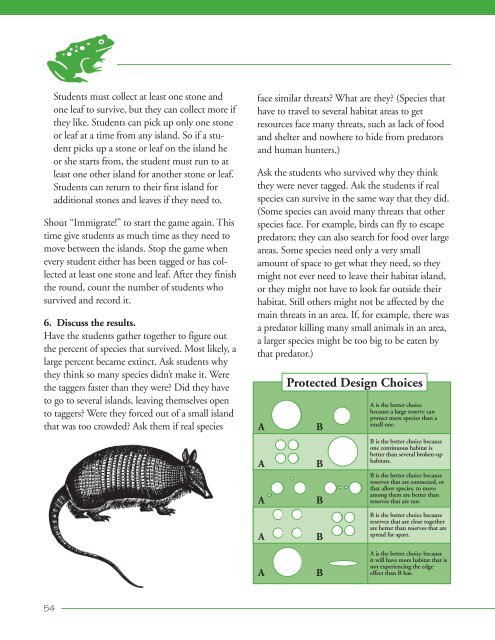EXPLORING BIODIVERSITY: A Guide for Educators Around the World
EXPLORING BIODIVERSITY: A Guide for Educators Around the World
EXPLORING BIODIVERSITY: A Guide for Educators Around the World
Create successful ePaper yourself
Turn your PDF publications into a flip-book with our unique Google optimized e-Paper software.
q<br />
Students must collect at least one stone and<br />
one leaf to survive, but <strong>the</strong>y can collect more if<br />
<strong>the</strong>y like. Students can pick up only one stone<br />
or leaf at a time from any island. So if a student<br />
picks up a stone or leaf on <strong>the</strong> island he<br />
or she starts from, <strong>the</strong> student must run to at<br />
least one o<strong>the</strong>r island <strong>for</strong> ano<strong>the</strong>r stone or leaf.<br />
Students can return to <strong>the</strong>ir first island <strong>for</strong><br />
additional stones and leaves if <strong>the</strong>y need to.<br />
Shout “Immigrate!” to start <strong>the</strong> game again. This<br />
time give students as much time as <strong>the</strong>y need to<br />
move between <strong>the</strong> islands. Stop <strong>the</strong> game when<br />
every student ei<strong>the</strong>r has been tagged or has collected<br />
at least one stone and leaf. After <strong>the</strong>y finish<br />
<strong>the</strong> round, count <strong>the</strong> number of students who<br />
survived and record it.<br />
6. Discuss <strong>the</strong> results.<br />
Have <strong>the</strong> students ga<strong>the</strong>r toge<strong>the</strong>r to figure out<br />
<strong>the</strong> percent of species that survived. Most likely, a<br />
large percent became extinct. Ask students why<br />
<strong>the</strong>y think so many species didn’t make it. Were<br />
<strong>the</strong> taggers faster than <strong>the</strong>y were? Did <strong>the</strong>y have<br />
to go to several islands, leaving <strong>the</strong>mselves open<br />
to taggers? Were <strong>the</strong>y <strong>for</strong>ced out of a small island<br />
that was too crowded? Ask <strong>the</strong>m if real species<br />
face similar threats? What are <strong>the</strong>y? (Species that<br />
have to travel to several habitat areas to get<br />
resources face many threats, such as lack of food<br />
and shelter and nowhere to hide from predators<br />
and human hunters.)<br />
Ask <strong>the</strong> students who survived why <strong>the</strong>y think<br />
<strong>the</strong>y were never tagged. Ask <strong>the</strong> students if real<br />
species can survive in <strong>the</strong> same way that <strong>the</strong>y did.<br />
(Some species can avoid many threats that o<strong>the</strong>r<br />
species face. For example, birds can fly to escape<br />
predators; <strong>the</strong>y can also search <strong>for</strong> food over large<br />
areas. Some species need only a very small<br />
amount of space to get what <strong>the</strong>y need, so <strong>the</strong>y<br />
might not ever need to leave <strong>the</strong>ir habitat island,<br />
or <strong>the</strong>y might not have to look far outside <strong>the</strong>ir<br />
habitat. Still o<strong>the</strong>rs might not be affected by <strong>the</strong><br />
main threats in an area. If, <strong>for</strong> example, <strong>the</strong>re was<br />
a predator killing many small animals in an area,<br />
a larger species might be too big to be eaten by<br />
that predator.)<br />
A<br />
A<br />
A<br />
A<br />
Protected Design Choices<br />
B<br />
B<br />
B<br />
B<br />
A is <strong>the</strong> better choice<br />
because a large reserve can<br />
protect more species than a<br />
small one.<br />
B is <strong>the</strong> better choice because<br />
one continuous habitat is<br />
better than several broken-up<br />
habitats.<br />
B is <strong>the</strong> better choice because<br />
reserves that are connected, or<br />
that allow species, to move<br />
among <strong>the</strong>m are better than<br />
reserves that are not.<br />
B is <strong>the</strong> better choice because<br />
reserves that are close toge<strong>the</strong>r<br />
are better than reserves that are<br />
spread far apart.<br />
A<br />
B<br />
A is <strong>the</strong> better choice because<br />
it will have more habitat that is<br />
not experiencing <strong>the</strong> edge<br />
effect than B has.<br />
54

















